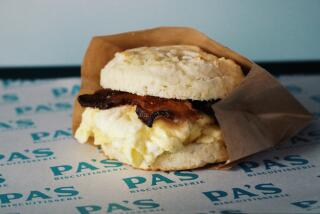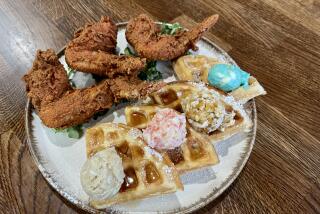Peanut Butter Still Family Favorite : Milestones: Peanut butter just celebrated its 100th birthday. Each day, it is estimated, 40 million Americans eat peanut butter sandwiches.
- Share via
Happy birthday, peanut butter. In case you have forgotten--or perhaps you never even knew--March 1 was National Peanut Butter Lover’s Day, honoring the 100th birthday of peanut butter as we know it.
Yes, peanut butter--that gooey, gluey, stick-to-the-roof-of-your-mouth substance that may in fact be more American than the venerable apple pie. After all, the French have their tarte tatin and tarte Normande, the Germans their apfelkuchen, but Europeans eat very little peanut butter.
In the United States, however, peanut butter is a daily favorite for millions. According to some estimates, 40 million Americans each day consume a peanut butter sandwich.
It is one of those rare bridges between generations and economic classes. From the unsteadiest of toddlers to the learned octogenarian, from the laid-off factory worker to the high and mighty industrialist, peanut butter is a staple many cannot do without.
Writer William F. Buckley Jr. is a peanut-butter fanatic, eating it every day for breakfast. He even devoted a 1981 column to the substance: “I have never composed poetry, but if I did, my very first couplet would be:
‘I know that I shall never see
‘A poem lovely as Skippy’s peanut butter.’ ”
CBS anchorman Dan Rather, who often packs a tube of peanut butter in his travel-survival kit, was spotted eating it on Tiananmen Square while covering the Chinese student uprising. One of the students thought it was a tube of toothpaste and asked to borrow it.
Talk-show host Larry King calls himself “a peanut butter freak. . . . If I were to go in the electric chair, peanut butter would be on the menu of my last meal,” he says. “I can’t believe how good it tastes. It breaks all the rules; it sticks to the roof of your mouth, it is not easy to spread, it’s yucky to feel. But it is the perfect food; with sliced bananas on white bread and a glass of cold milk, it’s tantamount to heaven on earth.”
Unfortunately, King is quick to note, he has been denied this slice of heaven since he underwent heart surgery in 1987. Although it is high in protein, doctors have barred him from eating his favorite food because it is too high in fat, he says.
Chris Evert is said to eat peanut butter on whole-grain bread as a last-minute snack before tennis matches. And just where does wrestler Big John Studd get his energy? Peanut butter, of course.
Then there was Elvis, one of the more famous peanut-butter fans of all time. His preferred sandwich: peanut butter and bananas, grilled in butter.
There are, of course, people who don’t think so fondly of peanut butter. Presidential brother Billy Carter once told a reporter that he couldn’t eat peanut butter because he was allergic to peanuts--a fine thing for a man whose family was in the peanut business.
And French chef and cooking instructor Francois Dionot has tried on many occasions to eat peanut butter. After all, he loves the taste of roasted peanuts. “But I can’t really come to like it,” he says. “Mostly it’s the consistency. It’s a gooey paste that I dislike very much. You can’t talk, you can’t do anything while you try to get rid of it,” says Dionot, director of L’Academie de Cuisine in Bethesda, Md.
But more often than not, it is the praises of peanut butter that one hears, no matter how it is eaten.
Even the ever-scrutinizing Consumers Report magazine has lauded it as the perfect fit for a school lunch box. “It won’t spoil at room temperature. It’s cheap enough to lose or forget on the bus. If the sandwich falls, it doesn’t fall apart.”
In short, the magazine said in a 1987 review of peanut butter, it “is a rare food--it tastes good and it’s good for you (and the kids). It’s inexpensive too.”
Besides jelly and bananas, favorite peanut-butter pairings are marshmallows, mayonnaise, pickle relish, deviled ham, catsup--basically anything that is spreadable.
Throughout the years, it has been eaten not only on bread, but on pancakes, celery sticks, fruit, ice cream and even tried on corn flakes with milk (although this combination was reported to be very messy and time-consuming to eat, since the peanut butter kept sticking to the spoon).
But the question of creamy or chunky deeply divides sandwich-eaters. Generally, children and women prefer the creamy version; chunky is more popular with adults and men. West Coast peanut-butter devotees have a preference for chunky, while Easterners fancy the creamier variety.
Overall, Americans are expected to eat 800 million pounds of peanut butter this year--more than double the 350 million pounds consumed in 1960, according to the Atlanta-based Peanut Advisory Board.
Looking at current consumption in another way, Americans will eat 10 billion peanut-butter sandwiches this year--or 3.3 pounds per person (up from two pounds per person 30 years ago), the board calculates.
Just why do people like something so gooey, gloppy and difficult to eat? “I think it’s deeply and darkly erotic, but a family newspaper probably shouldn’t explore that subject,” says columnist George Will, who eats a peanut-butter-and-sweet-pickle sandwich for lunch about two times a week. It was a habit, he says, that “was handed down in my family.”
Given the widespread love for peanut butter, it would be nice to know exactly who should get the credit for its creation. Unfortunately, the Peanut Advisory Board is not quite sure whether thanks should go to a doctor in St. Louis or a physician in Battle Creek, Mich. (whose last name just happened to be Kellogg).
Either way, the board is confident that the spread was created in 1890, with patents for peanut-grinding machines being issued several years later.
According to the peanut group, a St. Louis doctor--whose exact identity has never been traced--ground up peanuts into a paste that could be spread on bread as a nutritious protein substitute for his elderly patients whose teeth were so poor they could not eat meat.
The spreadable paste was a success, so the doctor then worked with George A. Bayle Jr., owner of a food-products company, who packaged and sold the spread under the name of Bayle Peanut Butter.
Around the same time, the Peanut Advisory Board says, Dr. John Harvey Kellogg discovered peanut butter in his search for vegetarian foods for patients at his sanitarium.
According to Kellogg Co. archives, Kellogg and his brother bought 10 pounds of peanuts, roasted them in the oven a little while, put the nuts in a pillow case to remove the hulls, winnowed out the husks and then put the remaining material through grain rollers to make peanut butter.
As business manager of the sanitarium, W.K. Kellogg opened Sanitas Nut Co. and supplied foods like peanut butter to the sanitarium and local grocery stores.
But after a while, Kellogg decided roasted peanuts were not wholesome, so he made the spread by another formula, steaming instead of roasting them. That spread, however, didn’t sell, so the Kelloggs lost what little business they had.
But many others benefitted, including one of their employees, Joseph Lambert, who received the first patent for a peanut-butter machine a few years later.
The rest is history, and a lucrative one at that. This year peanut-butter sales are expected to total about $1 billion.
More to Read
Eat your way across L.A.
Get our weekly Tasting Notes newsletter for reviews, news and more.
You may occasionally receive promotional content from the Los Angeles Times.










